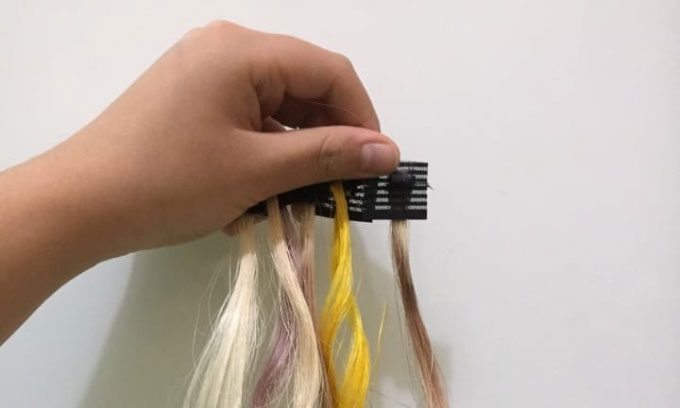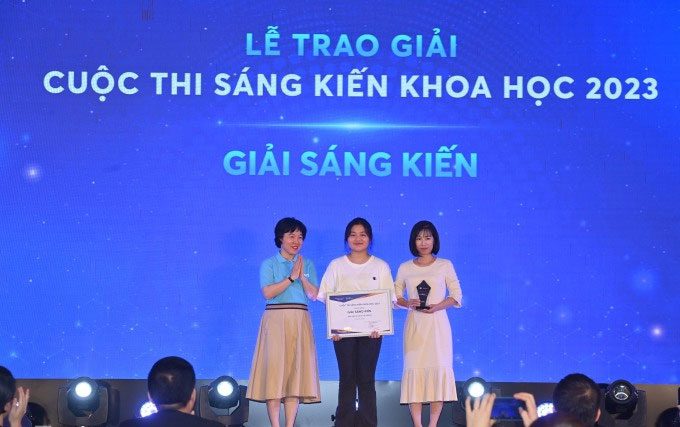The solution of using leaves from the *snake plant* to create fibers for making wigs by Trần Thị Quỳnh is expected to provide additional income for the community and won an award at the 2023 Science Initiative Competition.
Trần Thị Quỳnh (18 years old), from Mường Nhé High School in Mường Nhé District, Điện Biên Province, shared that the idea came to her while watching a program about cancer patients undergoing chemotherapy who were losing their hair and could not afford wigs. Quỳnh noted that real hair wigs are very expensive, while synthetic fibers can harm the environment during production. “I thought, why not make wigs from readily available natural materials, reducing costs while avoiding environmental pollution?”, Quỳnh said.
Under the guidance of teacher Nguyễn Thị Cẩm Nhung, Quỳnh explored and researched natural fibers sourced from cotton, silk, flax, and hemp, but found they were unsuitable for wig making due to their tendency to shrink and fray. While searching for new materials, the teacher and student focused on the *snake plant* for its advantages, such as strong fibers and a white color that easily takes dye, high durability, and no fraying. They found the plant grows wild in many villages, leading them to experiment with *snake plant* leaves to produce handmade fibers without chemicals.
To implement the project, the team harvested *snake plant* leaves, washed them, and used a pestle to crush the leaf flesh. They then fermented it with Emuniv probiotic for about 7-10 days. After soaking, the leaves would decompose, allowing them to extract the fiber. “The fibers are essentially tubular, and the strands are inside the leaves, so the cutin layer on both sides of the leaves needs to be removed to make it easier to extract the leaf flesh from the fibers,” Quỳnh explained, adding that medium-sized and older *snake plant* leaves provide stronger fibers that are less likely to break during extraction.
During production, the group added some nourishing products, such as aloe vera leaf extract and enzyme solutions from pineapple, orange, and lemon peels, to enhance the strength and softness of the fibers. After soaking for about 6 hours, the fibers were dried and stored. The resulting fibers were quite soft and showed no signs of mold after being stored at room temperature for 8 weeks. The finished wigs were tested by students at the school and remained in good condition after two years.

Wigs made from *snake plant* leaves created by students in Điện Biên. (Photo: NVCC).
The group also used natural dyes from turmeric, ripe malabar spinach fruits, and coffee powder to color the fibers before shaping them into wigs. To test the product’s heat resistance, they used a straightening and curling device at temperatures typically used for real hair. “The results showed that wigs made from *snake plant* fibers have good heat resistance and can easily change styles,” Quỳnh noted.
In an interview, teacher Nguyễn Thị Cẩm Nhung, head of the professional group and deputy chairperson of the Mường Nhé High School Trade Union, stated that the project’s greatest success lies in utilizing readily available and safe natural materials. “Although the research is still in its early stages, I am hopeful about the product’s development potential, which could provide new crops for economic efficiency and additional income for the community,” Nhung said.
The wigs and highlighted hair strands have been very popular among the students at the school. Nhung also revealed that some students were eager to participate in fiber extraction and created similar products to sell online for only about 8,000 to 10,000 VND per wig or to use as gifts. In addition to making wigs, the fibers can be used to craft makeup brushes, braided into ropes, woven into baskets, nets, hammocks, foot mats, dust brushes, bracelets, and other handmade items.
In the future, the group plans to further improve their wigs for greater shine and softness, weave the fibers into fabric pieces, and create packaging products and fashion handicrafts. Additionally, they intend to design a machine to press *snake plant* leaves for fiber extraction to reduce time and labor.

Student Trần Thị Quỳnh (center) and teacher Nguyễn Thị Cẩm Nhung receiving the innovation award. (Photo: Giang Huy)
The project received the “Innovation Award” at the 2023 Science Initiative Competition, with the jury recognizing it for its good idea and significant humanitarian value. While the technological novelty is not high, the initiative particularly supports remote and rural areas.




















































